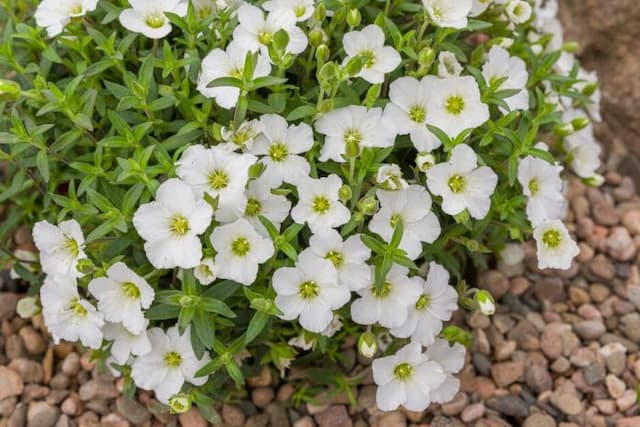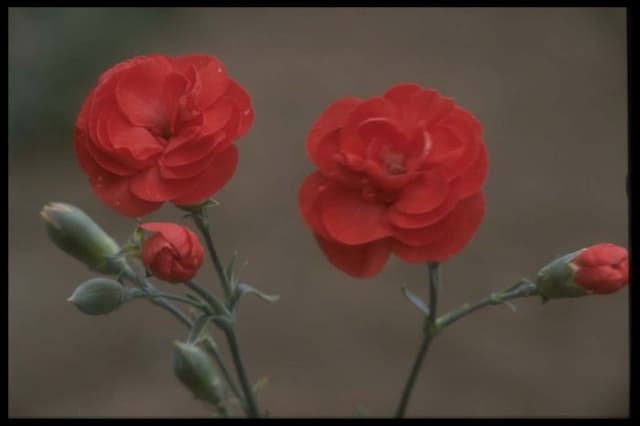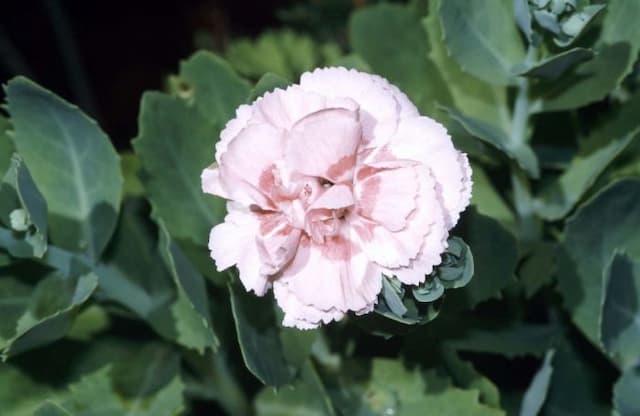Carnation Dianthus 'Crimson Chance' (p)

ABOUT
Dianthus 'Crimson Chance' is a captivating cultivar known for its distinctive flowers and foliage. The plant produces beautiful, deep crimson or scarlet petals which are often fringed or have a slightly serrated edge, giving them a lacy appearance. The petals can sometimes feature a lighter pink or white hue near the base, creating a striking contrast against the darker tips. These flowers exude a delightful, spicy clove-like fragrance that can be sensed from a distance, making it a favorite among gardeners who appreciate both visual beauty and aromatic qualities in their plant selections. The foliage of Dianthus 'Crimson Chance' is equally attractive, with slender, blue-green leaves that form a low-growing, dense and grassy clump. These needle-like leaves are evergreen in some climates, which means they can provide year-round interest even when the plant is not in bloom. The leaves are also noted for their neat, slightly glaucous appearance, which can enhance the aesthetic of mixed borders, rock gardens, or as edging along paths or beds. When in full bloom, this plant creates a vibrant show of color and adds an instant pop of brightness to any garden space. The flowers spread across the top of the stems, opening up to greet the sun and attract a host of pollinators such as bees and butterflies. This cultivar, with its striking blooms and handsome foliage, is a superb choice for anyone looking to add long-lasting and vivid color to their outdoor spaces.
About this plant
 Names
NamesSynonyms
Sweet William, Pinks, Carnation
Common names
Dianthus 'Crimson Chance'
 Toxicity
ToxicityTo humans
Dianthus, commonly known as Carnation, is not typically considered toxic to humans. However, if ingested in large quantities, it could potentially cause mild gastrointestinal upset. Generally, the Carnation is not associated with severe poisoning in humans, and accidental ingestion is unlikely to result in serious consequences.
To pets
Carnation is also not considered highly toxic to pets, but as with many plants, it can cause mild gastrointestinal distress if ingested. Symptoms might include vomiting or diarrhea, but serious poisoning is rare. It is always advisable to prevent your pets from ingesting plants to avoid any potential discomfort or reactions.
 Characteristics
CharacteristicsLife cycle
Perennials
Foliage type
Evergreen
Color of leaves
Blue-green
Flower color
Crimson
Height
1 foot 2-3 inches (35-40 cm)
Spread
1 foot (30 cm)
Plant type
Herb
Hardiness zones
5
Native area
Europe
Benefits
 General Benefits
General Benefits- Attracts Pollinators: Dianthus 'Crimson Chance' is known to attract bees, butterflies, and other beneficial insects, which are crucial for pollination and the health of the garden ecosystem.
- Low Maintenance: Once established, this variety of dianthus typically requires minimal care, making it suitable for gardeners of all levels.
- Drought Tolerant: It is relatively resistant to periods of low water availability, hence good for xeriscaping or in areas with water restrictions.
- Long Blooming Season: Dianthus 'Crimson Chance' have a lengthy flowering period, providing color and vibrancy to gardens for an extended time.
- Easy to Propagate: This plant can be readily propagated from cuttings or division, allowing gardeners to easily increase their stock.
- Versatile Use: Suitable for borders, pots, rock gardens, and as ground cover, offering flexibility in garden design.
- Fragrance: The flowers emit a delightful scent that can add an aromatic dimension to outdoor spaces.
- Cut Flowers: Makes excellent cut flowers for indoor decoration due to their attractive blooms and long vase life.
- Deer Resistant: Known to be less palatable to deer, which helps protect gardens in areas where deer browsing is a problem.
- Colorful Foliage: Beyond flowers, the foliage can also add color and interest to the garden throughout the growing season.
 Medical Properties
Medical PropertiesThis plant is not used for medical purposes.
 Air-purifying Qualities
Air-purifying QualitiesThis plant is not specifically known for air purifying qualities.
 Other Uses
Other Uses- As a natural fabric dye: The vibrant crimson color from the petals of the Dianthus can be used to dye fabrics and yarns in a natural, eco-friendly way.
- Decorative ice cubes: Freeze petals of Dianthus in ice cube trays to create decorative ice cubes for punches or cocktails at special events.
- Floral bath soak: Petals of the Dianthus can be added to bath water for a luxurious and fragrant floral soak.
- Edible cake decorations: The petals of the Dianthus flowers are edible and can be candied or used fresh as an elegant decoration on cakes and desserts.
- Scented stationary: When dried, the petals can be infused into paper to create scented stationary for a personal touch to letters and invitations.
- Natural confetti: Bright dried petals of the Dianthus can serve as biodegradable confetti for weddings and celebrations, offering an eco-friendly alternative to plastic confetti.
- Pressed flower art: Dianthus flowers can be pressed and used in art projects, such as creating bookmarks, framed art, or embellishing homemade cards.
- Potpourri: Dried petals and buds can be mixed with other botanicals and spices to create homemade potpourri.
- Floral pet bedding: Dianthus petals can be mixed into bedding for small pets like hamsters or rabbits to add a pleasant scent.
- Bookmarks: Laminating Dianthus petals to create beautiful, natural bookmarks can make for a special handmade gift.
Interesting Facts
 Feng Shui
Feng ShuiThe Carnation is not used in Feng Shui practice.
 Zodiac Sign Compitability
Zodiac Sign CompitabilityThe Carnation is not used in astrology practice.
 Plant Symbolism
Plant Symbolism- Love: The color crimson is traditionally associated with deep love and affection, which makes Dianthus 'Crimson Chance' a symbol of romantic and passionate love.
- Admiration: Dianthus flowers are generally symbols of admiration and the 'Crimson Chance' variety, with its striking appearance, may represent deep admiration for someone special.
- Boldness: The vivid crimson color of these flowers can symbolize boldness and daring, reflecting a person's courage to take chances or make significant life changes.
- Purity: Despite the bold color, dianthus flowers, in general, are also associated with purity and innocence which can be attributed to their simple yet profound beauty.
- Devotion: Dianthus 'Crimson Chance' can represent someone's unwavering devotion and commitment, suggestive of the flower's long-lasting nature.
- Fortune: The word 'chance' in its name might suggest a connection to good luck and fortune, making the flower a positive talisman.
 Water
WaterFor the carnation variety Dianthus 'Crimson Chance', provided water deeply once or twice a week to encourage deep roots, adjusting as necessary during hot, dry periods or rainy spells. Ensure that the soil drains well to avoid waterlogging. It's typically recommended to give the plant about 1 gallon of water per week, but this can depend on your climate and soil. In the summer or during heat waves, you might need to water more frequently, while in cooler weather or when the plant is not actively growing, you should reduce the frequency. Always check the soil moisture by feeling the top inch: if it's dry, it's time to water.
 Light
LightCarnations like Dianthus 'Crimson Chance' thrive in full sun conditions, receiving at least 6 to 8 hours of direct sunlight daily. They perform best in a spot that has bright and unfiltered light throughout the day, which promotes healthy growth and abundant flowering. If you're growing indoors, place them near a south-facing window where they can receive ample light. Avoid shady areas, as too little light can result in poor blooming and leggy plants.
 Temperature
TemperatureCarnations, such as Dianthus 'Crimson Chance', prefer cooler climates and do well in temperatures ranging between 40°F to 70°F. They can survive short periods of higher temperatures, but prolonged exposure above 85°F can be detrimental. Freezing temperatures below 32°F can damage or kill the plant, so protect it during hard freezes. The ideal growing conditions for carnations would be in an environment where the temperature remains consistently within the aforementioned range.
 Pruning
PruningPrune carnations like Dianthus 'Crimson Chance' to remove dead or faded flowers (deadheading), which encourages more blooms and helps maintain a neat appearance. Trim back the foliage after flowering to promote dense, bushy growth and better air circulation. Pruning is typically done in the late winter or early spring, before new growth begins. Cut back up to one-third of the plant's height to stimulate fresh growth.
 Cleaning
CleaningAs needed
 Soil
SoilThe best soil mix for the Carnation 'Crimson Chance' is well-draining, loamy or sandy with added organic matter. The ideal pH for Carnations should be slightly alkaline, around 7.0 to 7.5.
 Repotting
RepottingCarnations like 'Crimson Chance' should be repotted every 1-2 years to replenish the soil and accommodate root growth.
 Humidity & Misting
Humidity & MistingCarnation 'Crimson Chance' prefers average humidity levels and does not require high humidity to thrive.
 Suitable locations
Suitable locationsIndoor
Place in bright indirect light and keep soil slightly moist.
Outdoor
Full sun, well-drained soil, and regular deadheading.
Hardiness zone
3-9 USDA
 Life cycle
Life cycleDianthus 'Crimson Chance', commonly known as Pinks, starts its life cycle with seed germination in warm, well-drained soil, typically in spring or autumn. After sprouting, the seedlings grow into small rosettes of blue-green leaves, and with proper sunlight and water, they will develop into mature plants. In their first or second year, depending on conditions, they begin to produce sturdy stems topped with fragrant, vibrant crimson flowers, which usually bloom from late spring to early summer. After the blooming period, the plant sets seeds, which can be collected for propagation or allowed to self-sow in the garden. Pinks are perennial, and after the growing season, the foliage may die back, especially in colder climates, but the plant will go into dormancy and then regrow from the root system the following spring. Deadheading spent flowers can encourage a second flush of blooms and help extend the plant's life in the garden.
 Propogation
PropogationPropogation time
Spring-Early Summer
The most popular method of propagating the Dianthus 'Crimson Chance', also known as Carnation, is through cuttings. This technique is often employed in late spring to early summer when the plant is actively growing. To propagate by cuttings, a gardener should select healthy, non-flowering stems. A sharp knife is used to make a clean cut, producing a section of stem about 4 to 6 inches (10 to 15 centimeters) long. The lower leaves are then stripped off, and the cut end is dipped into rooting hormone powder to encourage root development. These prepared cuttings are inserted into a mix of peat and perlite or a well-draining soil mix, ensuring good contact between the stem and the medium. The cutting needs to be kept in a warm place with high humidity and indirect light until roots develop, which typically takes a few weeks.



![Pink [Tequila Sunrise]](/_next/image?url=https%3A%2F%2Fplants-admin.emdemapps.com%2Fimages%2Fplants%2F%2Fimages%2F604b5d995d06e.png&w=640&q=75)





